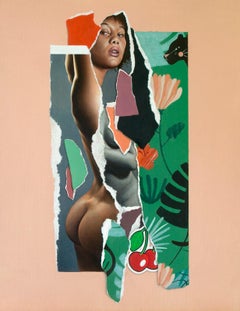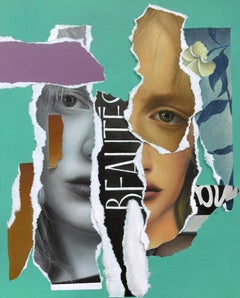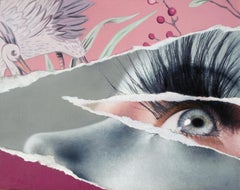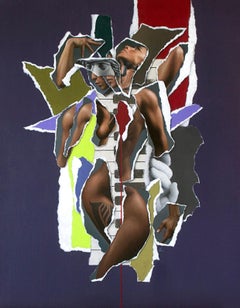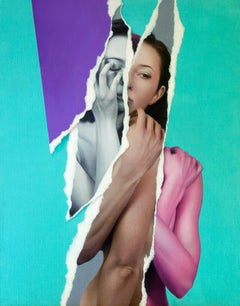Grant Gilsdorf Art
to
6
6
5
"Remix’D-6 (Peach Tea)" Oil Painting
By Grant Gilsdorf
Located in Denver, CO
Grant Gilsdorf's "Remix’D-6 (Peach Tea)" is an original, handmade oil painting that depicts a Black female model eclipsed by flora iconography.
About the Artist:
Grant Gilsdorf is ...
Category
2010s Contemporary Grant Gilsdorf Art
Materials
Oil, Panel
"Remix’D-2 (Mint)" Oil Painting
By Grant Gilsdorf
Located in Denver, CO
Grant Gilsdorf's "Remix’D-2 (Mint)" is an original, handmade oil painting that depicts a female model's face eclipsed by floral patterns and text.
About the Artist:
Grant Gilsdorf ...
Category
2010s Contemporary Grant Gilsdorf Art
Materials
Oil, Panel
"Remix’D-3 (Rose)" Oil Painting
By Grant Gilsdorf
Located in Denver, CO
Grant Gilsdorf's "Remix’D-3 (Rose)" is an original, handmade oil painting that depicts a female model eclipsed by pink and bird patterned wallpaper.
About the Artist:
Grant Gilsdor...
Category
2010s Contemporary Grant Gilsdorf Art
Materials
Oil, Panel
"Remix’D-5 (Grape Soda)" Oil Painting
By Grant Gilsdorf
Located in Denver, CO
Grant Gilsdorf's "Remix’D-5 (Grape Soda)" is an original, handmade oil painting that depicts a Black female model eclipsed by ancient Greek sculpture...
Category
2010s Contemporary Grant Gilsdorf Art
Materials
Oil, Panel
"Remix’D-4 (Blue Slushie)" Oil Painting
By Grant Gilsdorf
Located in Denver, CO
Grant Gilsdorf's "Remix’D-4 (Blue Slushie)" is an original, handmade oil painting that depicts a female model eclipsed by other figural forms.
About the Artist:
Grant Gilsdorf is a...
Category
2010s Contemporary Grant Gilsdorf Art
Materials
Oil, Panel
Chainz
By Grant Gilsdorf
Located in Denver, CO
Chainz, 2021
Category
21st Century and Contemporary Grant Gilsdorf Art
Materials
Oil, Panel
Related Items
Venice at Dusk
By Lucien Whiting Powell
Located in Milford, NH
A fine Italian coastal oil painting with boats titled “Venice at Dusk” by American artist Lucien Whiting Powell (1846-1930). Powell was born in Levinworth Manor, Virginia, joined the 11th Virginia Cavalry at 17 and fought in the Civil War, pursuing his art career after the war, studying with Thomas Moran in Philadelphia and at the Pennsylvania Academy of the Fine Arts. He is also said to have studied in New York City, probably with Moran who moved there in 1872. He was an admirer of British artist J...
Category
Early 20th Century American Impressionist Grant Gilsdorf Art
Materials
Canvas, Oil, Panel
Portrait of Love- 21st Century Contemporary Four Panel Painting of a love couple
By Tania Rivilis
Located in Nuenen, Noord Brabant
Tania Rivilis
Portrait of Love
Four panels of 40x40 cm all together framed in one piece of 94x94 cm
Oilpaint on wood panel
Tania Rivilis (b. 1986) 2022 winner of the 'William Locke Price' ( £ 30.000 ) from the Royal Society of Portrait Painters UK.
Tania Rivilis began painting at the age of 27, after moving to Germany from Russia in 2012. Working hard on technique and creating her own signature style, just one year later Tania entered the art world with her first solo shows. Tania’s works range from classical to modern expressive style. For several years of working with painting and graphics, the artist held exhibitions in Germany, the Netherlands, and Russia.
In 2016 began a collaboration between Tania Rivilis and Russian jeweler Petr Axenov, which led to many special projects, both for private and state collections. Her two drawings based on “War and Peace” novel by Leo Tolstoy...
Category
2010s Contemporary Grant Gilsdorf Art
Materials
Wood Panel, Oil
Free Shipping
H 37.01 in W 37.01 in D 1.97 in
Portrait Gentleman Black Coat Orange Sash, Dutch Old Master, Oil on Panel c.1650
By Bartholomeus van der Helst
Located in London, GB
This exquisite portrait of a gentleman depicted in a sumptuous black coat edged with silver and slashed sleeves is an excellent example of the type of portrait fashionable in England and the Low Countries during the 17th century. The confident pose, striking orange sash - the colour of the house of Orange Nassau - and the leather gorget imbue the sitter with a sense of masculinity and power. The profusely decorated costume is of the highest quality and de rigueur of an elite class - the artist has carefully cultivated this portrait to emphasise the sitter’s wealth and standing in the society that he belonged to. The casual pose, with one arm resting on a hip, is much less formal than earlier decades, and it speaks of ‘sprezzatura’ – one’s appearance should not appear laborious, but instead, effortless.
The oil on cradled panel portrait can be dated to circa 1650 based on the hairstyle and the attire - small falling collar, short doublet (doublets reduced in size to just below the ribcage in the late 1650’s), and the type of slashed sleeves with the sleeve seams left open to reveal the white fabric.
The demand for portraits in the Netherlands was great in the 17th century. Bartholemeus van der Helst was considered to be one of the leading portrait painters of the Dutch Golden Age surpassing even Rembrandt as the most sought-after portraitist in Harlaam. The Dutch Golden Age, roughly spanning the 17th century, was a period when Dutch trade, science, military, and art were among the most acclaimed in the world. Dutch explorers charted new territory and settled abroad. Trade by the Dutch East-India Company thrived, and war heroes from the naval battles were decorated and became national heroes. During this time, The Dutch Old Masters began to prevail in the art world, creating a depth of realistic portraits of people and life in the area that has hardly been surpassed. The Golden Age painters depicted the scenes that their discerning new middle-class patrons wanted to see. This new wealth from merchant activities and exploration combined with a lack of church patronage, shifted art subjects away from biblical genres. Still life’s of items of everyday objects, landscapes, and seascapes reflecting the naval and trade power that the Republic enjoyed were popular. The new wealthy class were keen to have their portraits commissioned and many artists worked in this lucrative field. Such was the popularity of art that everyone had a painting, even the humble butcher, and hundreds of thousands of paintings were produced.
By tradition the sitter is Maarten Tromp (1598-1653) who was an Admiral in the Dutch Navy (the reverse of the portrait contains an old handwritten inscription “van Tromp”). Certainly, the distinctive orange sash is similar to those worn by officers of the Dutch army in the Netherlands who served under the Princes of Orange and the House of Nassau. However, it should be noted that the physiognomy differs from other images of Tromp.
Tromp was the oldest son of Harpert Maertensz, a naval officer and captain. He joined the Dutch navy as a lieutenant in July 1622 and was later promoted from captain to Lieutenant-Admiral of Holland and West Frisia in 1637. In 1639, during the Dutch struggle for independence from Spain, Tromp defeated a large Spanish fleet bound for Flanders at the Battle of the Downs, which marked an enormous change - the end of Spanish naval power. He was killed in action during the First Anglo-Dutch War in 1653 where he commanded the Dutch fleet in the battle of Scheveningen.
Gloves were an absolutely vital accessory and the elaborate pair in this portrait are embellished with threads of silk and precious metals and salmon-coloured lining. He wears only one glove and holds the other, providing an opportunity to better display the cuffs and detail on his right wrist and forearm. The gloves are probably made from the most prized leather which came from Spain, in particular from Cordova. Cordovan leather was tanned with a special vegetal process that left it both highly impermeable and divinely soft. King Charles I, posed in a rather relaxed manner for Daniel Mytens’s portrait in 1631, is wearing gloves and boots in matching Cordovan leather. The hide is thick, but you can see just how supple it is from the way the gauntlet dimples and the long boot legs fold over themselves, rippling and wrinkling at the ankles.
Apart from keeping hands warm the use of gloves during the 15th through the 19th centuries were full of symbolism and they were worn regardless of the season. They kept the skin unblemished - soft, smooth hands were considered highly attractive. This combination of necessity and proximity to bare skin made gloves a deeply personal gift and they took on a strong symbolic significance and were regarded as emblematic of fidelity and loyalty for hundreds of years. Such was the importance of their symbolism was that some gloves were never intended to be worn at all. Their luxury made them ideal gifts at court, and so in the 15th and 16th centuries, ambassadors often presented them as symbols of loyalty.
Until the mid-19th century, it was customary to give gloves as tokens to guests at weddings and to mourners at funerals. Gentleman often gifted their bride-to-be with a pair of gloves (the obligatory gift) and were handed over at the betrothal and put on display before the wedding took place. It was probably their direct contact with the skin that led to the eroticism of gloves. Not only were pairs often exchanged between lovers, but from the 16th to the 18th centuries, it was common practice to remove one glove and give it as a gift to a favourite. The idea of the item being presented still warm from the wearer’s hand is certainly suggestive. Following the death of King George IV, his executors purportedly found over a thousand mismatched ladies’ gloves among his possessions.
The sentiment of a 17th-century poem reveals the popularity of the practice: “Come to our wedding to requite your loves / Shew us your hands and we’ll fit you with gloves.” Such generosity might be pricey for the hosts, but gloves of varying quality could be offered depending on the status of the recipient. Pairs made with the finest Spanish leather might be reserved for immediate family, while coarse sheep’s leather could be distributed among the servants and tradesmen. The apportioning of quality according to class provided a very clear message of the gloves’ intended use. For refined guests, they were decoration; for the lower classes, they were functional.
Bartholomeus van der Helst...
Category
17th Century Old Masters Grant Gilsdorf Art
Materials
Oil, Wood Panel
H 38.59 in W 31.89 in D 2.76 in
Hortus Conclusus- 21st Century Contemporary Portrait Painting of a Girl
By Pam Hawkes
Located in Nuenen, Noord Brabant
This remarkable painting is made by Pam Hawkes. This British artist is new to the Netherlands, her work is now a household name in the rest of the world. We're proud to represent her...
Category
2010s Contemporary Grant Gilsdorf Art
Materials
Copper
Free Shipping
H 22.84 in W 22.84 in
Portrait of Gentleman, Thomas Bruce, Earl of Elgin c.1638 Manor House Provenance
Located in London, GB
Titan Fine Art present this picture which formed part of a historic collection of an English aristocratic family, Lord and Lady Sandys at their magnificent baroque and Regency Grade-...
Category
17th Century Old Masters Grant Gilsdorf Art
Materials
Oil, Wood Panel
H 18.9 in W 16.15 in D 1.58 in
Peach XI-Original hyper realism still life oil painting-artwork-contemporary art
By Angela Faustina
Located in London, Chelsea
Angela Faustina's "Peach XI" transports viewers into a realm of hyperrealism, where the luscious allure of a juicy peach is brought to life with breathtaking clarity. As an original ...
Category
21st Century and Contemporary Realist Grant Gilsdorf Art
Materials
Oil, Panel
Free Shipping
H 11.82 in W 11.82 in D 1.19 in
Terra Nullis-21st Century Contemporary Iconic Painting of a Girl in blue dress
By Pam Hawkes
Located in Nuenen, Noord Brabant
This British artist is new to the Netherlands, her work is now a household name in the rest of the world. We understand why.
A painting by Pam Hawkes is something remarkable. At th...
Category
2010s Contemporary Grant Gilsdorf Art
Materials
Copper
Free Shipping
H 40.16 in W 25.2 in
Unspoken- 21st Century Contemporary Painting of a boycouple
By Tania Rivilis
Located in Nuenen, Noord Brabant
Tania Rivilis
Unspoken
63 x 45 cm
Oil on wood panel
First we can announce some wonderful news! 3 May 2022 Tania Rivilis did win the first price of the Royal Academy of Portraitpain...
Category
2010s Contemporary Grant Gilsdorf Art
Materials
Oil, Wood Panel
Free Shipping
H 24.81 in W 17.72 in D 0.79 in
The Old Barn, Jackson
By Harry Leslie Hoffman
Located in Milford, NH
A lovely impressionist winter oil painting with a farmer going into the barn painted by American artist by Harry Leslie Hoffman (1874-1966). Hoffman was born in Cressona, Pennsylvania, studied in Paris, worked at Yale University, and was a student at the Art Students League with Frank DuMond. He spent much of his life associated with the Old Lyme Colony in Old Lyme, Connecticut. His work was greatly influenced by the impressionist style of Willard Metcalf and became well known for his landscapes, still lifes, and underwater paintings. Oil on panel, signed lower right and on verso, titled in pencil on verso “The Old Barn...
Category
Mid-20th Century American Impressionist Grant Gilsdorf Art
Materials
Oil, Panel
Spring- 21st Century Contemporary
By Pam Hawkes
Located in Nuenen, Noord Brabant
This painting is made by Pam Hawkes. On the painting you see the portrait of a woman
This British artist is new to the Netherlands, her work is now a household name in the rest of ...
Category
2010s Contemporary Grant Gilsdorf Art
Materials
Gold Leaf
Portrait of a Lady in an Elaborate Ruff & Lace Coif c.1610-20, Dutch Old Master
Located in London, GB
This magnificent oil on panel portrait, presented by Titan Fine Art, is a splendid example of the sumptuous female portraits that were painted for members of the upper echelons of society during the early part of the 1600’s. The artist has rendered this portrait with meticulous attention to detail and the surface effects of the fine materials. The elaborate lace coif and cuffs are painstakingly delineated, as is the bold black damask, and sumptuous gold decoration of her skirt and stomacher, which is wonderfully preserved and quite remarkable considering the age of the work and the fact that darker pigments are particularly vulnerable to fading and wear. This work with its spectacular depiction of costume is of absolute quality, it can be rated as one of the best works in the artist’s oeuvre and as such it is an important and splendid example of Dutch portraiture.
The Dutch Golden Age of painting was a period in Dutch history, roughly spanning the 17th century, in which Dutch trade, science, military, and art were among the most acclaimed in the world. Dutch explorers charted new territory and settled abroad. Trade by the Dutch East-India Company thrived, and war heroes from the naval battles were decorated and became national heroes. During this time, The Dutch Old Masters began to prevail in the art world, creating a depth of realistic portraits of people and life in the area that has hardly been surpassed. The Golden Age painters depicted the scenes that their discerning new middleclass patrons wanted to see. This new wealth from merchant activities and exploration combined with a lack of church patronage, shifted art subjects away from biblical genres.
Dress was a key component in portraits, and the exuberant attire reiterates the incredible wealth of this woman. The sitter will have visited the artist’s workshop and inspected examples on display. They would have chosen the size and the sort of composition and on that basis negotiated the price – which would have also been determined by the complexity of the clothing and the jewels that were to be depicted, and by the materials to be used. When all was considered, this portrait would have cost the sitter (or her husband) a substantial sum.
The colour black was regarded as humble and devout yet at the same time refined and sophisticated and the most expensive colour of fabric to dye and to maintain. Citizens spent fortunes on beautiful black robes. Such uniformity must also have had a psychological side-effect and contributed to a sense of middle-class cohesion; the collective black of the well-to-do burgess class will have given its members a sense of solidarity. The colour was always an exciting one for artists and when this portrait was painted there were at least fifty shades of it, and as many different fabrics and accoutrements. Artists went to great lengths to depict the subtle nuances of the colour and the fabrics and textures and how they reflected light and it was an ideal background against which gold and crisp white lace could be juxtaposed to dramatic effect.
The sitter is either a married women or a widower as is evident by the clothing that she wears and the position, toward her right, it is highly likely that this portrait was once a pendant that hung on the right-hand side of her husband’s portrait as was convention at the time. She wears a vlieger which was a type of sleeveless over-gown or cape worn by well-to-do married women in the late 16th and early 17th centuries. Variations with short sleeves or high shoulder rolls are known. Sometimes sleeves were attached with aiglets, and often slits were made to allow belts or the hands to pass through. Three-piece vlieger costumes of this kind were standard items of clothing in portraits of the women of the civic elite in the period 1600-40 and was a variant of the Spanish ‘ropa’ and served as a trademark of well-to-do married burgher women. Girls and unmarried woman, including beguines, wore a bouwen (a dress with a fitted bodice and a skirt that was closed all round) instead. This clear distinction between apparel for married and unmarried women is clear not only from inventories and trousseau lists, but also from contemporary sources such as the Dutch Spanish dictionary published by Juan Rodrigues in 1634. In it, a bouwen is described as a ‘ropa de donzella’ (over-gown worn by a virgin) and a vlieger as a ‘ropa de casada’ (overgown worn by a married woman). It is striking how few women are depicted wearing a bouwen, unless they are part of a group, family or children’s portrait and it can therefore be assumed that independent portraits of unmarried women were seldom commissioned. It is also believed that the clothing worn in these portraits existed and were faithfully reproduced when cross-referenced with the few exact documents. These sources also demonstrate that clients wanted their clothing to be depicted accurately and with this in mind precious garments and jewels were often left in the painter’s studio.
The prominent white lawn molensteenkraag (or millstone ruff) is held up by a wire supportasse and was reserved only for the citizens that could afford this luxurious item that often required 15 meters of linen batiste. The fabulous wealth of this sitter is also evident by the elaborate lace coif and cuffs which have been exquisitely depicted; lace was often literally copied by artists in thin white lines over the completed clothing.
The gold bracelet with jewels is a type that was evidently fashionable as it is seen in a number of portraits during the 1610s and 1620. Clothing and jewellery were prized possessions and were often listed in inventories of estates and passed down from generation to generation. There were a great number of jewellers of Flemish origin working at all the courts and cities of Europe, competing with the Italians, and then the French, adapting themselves to the tastes and positions of their patrons and the raw materials available in the country where they worked. The fashion for jewels “in the Flemish style” succeeded that of the Italian style.
Cornelis van der Voort, who was probably born in Antwerp around 1576, came to Amsterdam with his parents as a child. His father, a cloth weaver by trade, received his citizenship in 1592. It is not known who taught the young Van der Voort to paint, but it has been suggested that it was either Aert Pietersz or Cornelis Ketel. On 24 October 1598 Van der Voort became betrothed to Truytgen Willemsdr. After his first wife’s death he became betrothed to Cornelia Brouwer of Dordrecht in 1613. In addition to being an artist, Van der Voort was an art collector or dealer, or both. In 1607 he bought paintings from the estate of Gillis van Coninxloo, and after an earlier sale in 1610 a large number of works he owned were auctioned on 7 April 1614. Van der Voort is documented as appraising paintings in 1612, 1620 and 1624. In 1615 and 1619 he was warden of the Guild of St Luke. He was buried in Amsterdam’s Zuiderkerk on 2 November 1624, and on 13 May 1625 paintings in his estate were sold at auction.
Van der Voort was one of Amsterdam’s leading portrait painters in the first quarter of the 17th century. Several of his group portraits are known. It is believed that he trained Thomas de Keyser (1596/97-1667) and Nicolaes Eliasz Pickenoy (1588-1650/56). His documented pupils were David Bailly (c. 1584/86-1657), Louis du Pré...
Category
17th Century Old Masters Grant Gilsdorf Art
Materials
Oil, Wood Panel
H 44.89 in W 35.83 in D 2.37 in
Torre Velasca
Located in Milano, MI
Urbex is the English acronym for urban exploration and is an activity that consists of searching for and locating abandoned infrastructure with the goal of visiting, photographing and conveying its contents, with particular involvement of methodologies from geography, anthropology, sociology to cultural studies.
Her works have been in the past approached to the works of Anselm Kiefer (b. 1945) and Giovanni Battista Piranesi (1720-1770), but in Gullotta's paintings the absence of color makes the spaces particularly ethereal, allowing them to be ideally lifted to new places and to new life.
An artist of international caliber who has decided to entrust her return to her homeland to Almach Art Gallery in Milan, while maintaining connections with important galleries, such as Marlborough Fine Art in London and Galerie Koch in Hanover.
The artwork represents the famous Velasca Tower in Milan.
This artwork was exhibited during the Daniela Gullotta...
Category
2010s Contemporary Grant Gilsdorf Art
Materials
Sandstone
Previously Available Items
"Remix’D-1 (Lavender)" Oil Painting
By Grant Gilsdorf
Located in Denver, CO
Grant Gilsdorf's "Remix’D-1 (Lavender)" is an original, handmade oil painting that depicts a female model's face eclipsed by floral patterns and ancient Greek sculpture.
About the ...
Category
2010s Contemporary Grant Gilsdorf Art
Materials
Panel, Oil
Chroma
By Grant Gilsdorf
Located in Denver, CO
Grant Gilsdorf's "Chroma" is an original, handmade oil painting that depicts a portrait of a female model in profile as her face is split by blue and fuchsia hued light with the yell...
Category
21st Century and Contemporary Grant Gilsdorf Art
Materials
Oil
"New School, " Oil Painting
By Grant Gilsdorf
Located in Denver, CO
Grant Gilsdorf's "New School" is an original, handmade oil painting that depicts a Black woman with red Betta fish swimming around her nude form.
Artist Statement about "New School":
"Betta fish serve as a specific symbolic choice within this painting. Betta fish are known to battle or cannibalize each other if placed in a small tank together. It calls to mind the same pressure our culture sets for...
Category
2010s Surrealist Grant Gilsdorf Art
Materials
Canvas, Oil
Grant Gilsdorf art for sale on 1stDibs.
Find a wide variety of authentic Grant Gilsdorf art available for sale on 1stDibs. If you’re browsing the collection of art to introduce a pop of color in a neutral corner of your living room or bedroom, you can find work that includes elements of blue and other colors. You can also browse by medium to find art by Grant Gilsdorf in oil paint, paint, panel and more. Much of the original work by this artist or collective was created during the 21st century and contemporary and is mostly associated with the contemporary style. Not every interior allows for large Grant Gilsdorf art, so small editions measuring 8 inches across are available. Customers who are interested in this artist might also find the work of Juan C. Estrada, Leon Sarantos, and Yugal Kishor Sharma. Grant Gilsdorf art prices can differ depending upon medium, time period and other attributes. On 1stDibs, the price for these items starts at $990 and tops out at $2,600, while the average work can sell for $1,675.
